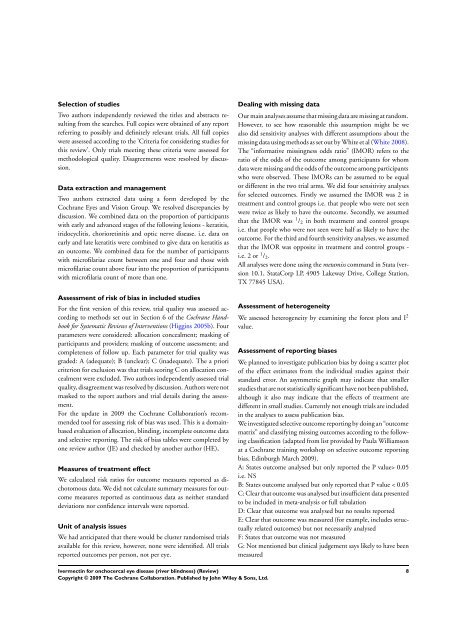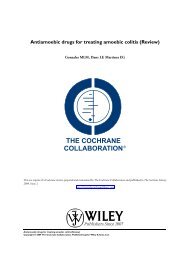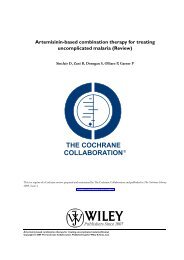Ivermectin for onchocercal eye disease (river blindness) (Review)
Ivermectin for onchocercal eye disease (river blindness) (Review)
Ivermectin for onchocercal eye disease (river blindness) (Review)
You also want an ePaper? Increase the reach of your titles
YUMPU automatically turns print PDFs into web optimized ePapers that Google loves.
Selection of studies<br />
Two authors independently reviewed the titles and abstracts resulting<br />
from the searches. Full copies were obtained of any report<br />
referring to possibly and definitely relevant trials. All full copies<br />
were assessed according to the ’Criteria <strong>for</strong> considering studies <strong>for</strong><br />
this review’. Only trials meeting these criteria were assessed <strong>for</strong><br />
methodological quality. Disagreements were resolved by discussion.<br />
Data extraction and management<br />
Two authors extracted data using a <strong>for</strong>m developed by the<br />
Cochrane Eyes and Vision Group. We resolved discrepancies by<br />
discussion. We combined data on the proportion of participants<br />
with early and advanced stages of the following lesions - keratitis,<br />
iridocyclitis, chorioretinitis and optic nerve <strong>disease</strong>. i.e. data on<br />
early and late keratitis were combined to give data on keratitis as<br />
an outcome. We combined data <strong>for</strong> the number of participants<br />
with microfilariae count between one and four and those with<br />
microfilariae count above four into the proportion of participants<br />
with microfilaria count of more than one.<br />
Assessment of risk of bias in included studies<br />
For the first version of this review, trial quality was assessed according<br />
to methods set out in Section 6 of the Cochrane Handbook<br />
<strong>for</strong> Systematic <strong>Review</strong>s of Interventions (Higgins 2005b). Four<br />
parameters were considered: allocation concealment; masking of<br />
participants and providers; masking of outcome assessment; and<br />
completeness of follow up. Each parameter <strong>for</strong> trial quality was<br />
graded: A (adequate); B (unclear); C (inadequate). The a priori<br />
criterion <strong>for</strong> exclusion was that trials scoring C on allocation concealment<br />
were excluded. Two authors independently assessed trial<br />
quality, disagreement was resolved by discussion. Authors were not<br />
masked to the report authors and trial details during the assessment.<br />
For the update in 2009 the Cochrane Collaboration’s recommended<br />
tool <strong>for</strong> assessing risk of bias was used. This is a domainbased<br />
evaluation of allocation, blinding, incomplete outcome data<br />
and selective reporting. The risk of bias tables were completed by<br />
one review author (JE) and checked by another author (HE),<br />
Measures of treatment effect<br />
We calculated risk ratios <strong>for</strong> outcome measures reported as dichotomous<br />
data. We did not calculate summary measures <strong>for</strong> outcome<br />
measures reported as continuous data as neither standard<br />
deviations nor confidence intervals were reported.<br />
Unit of analysis issues<br />
We had anticipated that there would be cluster randomised trials<br />
available <strong>for</strong> this review, however, none were identified. All trials<br />
reported outcomes per person, not per <strong>eye</strong>.<br />
<strong>Ivermectin</strong> <strong>for</strong> <strong>onchocercal</strong> <strong>eye</strong> <strong>disease</strong> (<strong>river</strong> <strong>blindness</strong>) (<strong>Review</strong>)<br />
Copyright © 2009 The Cochrane Collaboration. Published by John Wiley & Sons, Ltd.<br />
Dealing with missing data<br />
Our main analyses assume that missing data are missing at random.<br />
However, to see how reasonable this assumption might be we<br />
also did sensitivity analyses with different assumptions about the<br />
missing data using methods as set out by White et al (White 2008).<br />
The “in<strong>for</strong>mative missingness odds ratio” (IMOR) refers to the<br />
ratio of the odds of the outcome among participants <strong>for</strong> whom<br />
data were missing and the odds of the outcome among participants<br />
who were observed. These IMORs can be assumed to be equal<br />
or different in the two trial arms. We did four sensitivity analyses<br />
<strong>for</strong> selected outcomes. Firstly we assumed the IMOR was 2 in<br />
treatment and control groups i.e. that people who were not seen<br />
were twice as likely to have the outcome. Secondly, we assumed<br />
that the IMOR was 1 /2 in both treatment and control groups<br />
i.e. that people who were not seen were half as likely to have the<br />
outcome. For the third and fourth sensitivity analyses, we assumed<br />
that the IMOR was opposite in treatment and control groups -<br />
i.e. 2 or 1 /2.<br />
All analyses were done using the metamiss command in Stata (version<br />
10.1, StataCorp LP, 4905 Lakeway Drive, College Station,<br />
TX 77845 USA).<br />
Assessment of heterogeneity<br />
We assessed heterogeneity by examining the <strong>for</strong>est plots and I 2<br />
value.<br />
Assessment of reporting biases<br />
We planned to investigate publication bias by doing a scatter plot<br />
of the effect estimates from the individual studies against their<br />
standard error. An asymmetric graph may indicate that smaller<br />
studies that are not statistically significant have not been published,<br />
although it also may indicate that the effects of treatment are<br />
different in small studies. Currently not enough trials are included<br />
in the analyses to assess publication bias.<br />
We investigated selective outcome reporting by doing an “outcome<br />
matrix” and classifying missing outcomes according to the following<br />
classification (adapted from list provided by Paula Williamson<br />
at a Cochrane training workshop on selective outcome reporting<br />
bias, Edinburgh March 2009).<br />
A: States outcome analysed but only reported the P value> 0.05<br />
i.e. NS<br />
B: States outcome analysed but only reported that P value < 0.05<br />
C: Clear that outcome was analysed but insufficient data presented<br />
to be included in meta-analysis or full tabulation<br />
D: Clear that outcome was analysed but no results reported<br />
E: Clear that outcome was measured (<strong>for</strong> example, includes structually<br />
related outcomes) but not necessarily analysed<br />
F: States that outcome was not measured<br />
G: Not mentioned but clinical judgement says likely to have been<br />
measured<br />
8








